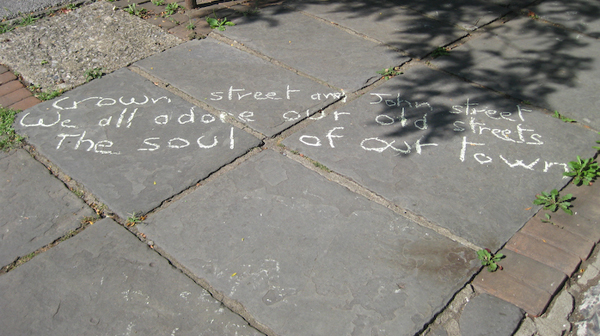How (and Why) to Love Your Bluestone Sidewalk
Not going into a lot of boring facts such as when bluestone was formed (375 million years ago), where it’s found (mainly just around Ulster and some neighboring counties), where you’ll find it outside of Kingston (Hudson Valley towns, New York City, eastern seaboard), when it was quarried as a big business (mainly 1840-1920), where you can find some today (more later),…
Bluestone is rare…it is part of what you picture when you close your eyes and think about Kingston and what makes it not Peoria or someplace else. It is priceless. It is one-time. When it is gone, Kingston will be more like everyplace else. And it is currently disappearing. Overlaid with asphalt or concrete. Removed by workers to…? Etc.
But there is still a lot left. About 60 to 80% of the original bluestone sidewalks in Kingston (every street and house before about 1920) are still there (the rest has been replaced by concrete or asphalt).
The curbstones are bluestone, too. Let’s save them, too.
Why is/was bluestone a good material? Relatively easy to make layered slabs (sedimentary), nonslippery surface, durable, pleasing color, locally available, can be worked into a number of forms. But it’s not invincible. Here’s how to preserve it and repair it. (See the Guide.)

Possible discussion:
Should the City of Kingston have a policy about its heritage of bluestone sidewalks? Should you and I be required to maintain our sidewalks as bluestone if that’s what they currently are? If not, how much longer will this be a unique and valuable feature of our city? What do you think?
A Guide for Maintaining Your Bluestone Sidewalk
Grass and other roots on the side or between stones can upheave the stones. Remove grass and fill with fine gray gravel. If gaps are big, fill with smaller pieces of bluestone or old brick fragments. Pour vinegar on grass to kill it; then remove it the next day. Ideally, build a border of gravel along the bluestone to discourage roots from spreading.
Try not to drop anything really heavy on your sidewalk or drive a truck over bluestone that wasn’t designed for the weight.
Where you have a cracked piece of flagstone that’s broken into, say, five pieces, consider: (A) Leaving it the way it is (it’s still bluestone), (B) filling in the cracks with cement that matches the stone in color, or (C) replacing it with a new piece of bluestone.
For replacement stones or new bluestone sidewalks, Delaware County bluestone (rule of thumb is $25 a square foot) is thinner and generally lighter in color. Older, heavier bluestone from Ulster County quarries or stockpiles will cost more but be more likely to match. For a single stone replacement, try to match your existing sidewalks stones as closely as possible.
If you hire a masonry firm to place the stone(s) for you, they can work with you on finding the right quality stones (you don’t have to locate the replacement stone yourself).
For foundations: it’s important to replace old mortar so that water can’t gather or seep through. The mortar should match the stone in color. Be sure to make sure the mason colors the mortar.
For your driveway, consider: gravel, new or old bricks, interlocking bricks, concrete colored to match the bluestone, or some combination. Plan for the weight you can reasonably expect on the driveway.
